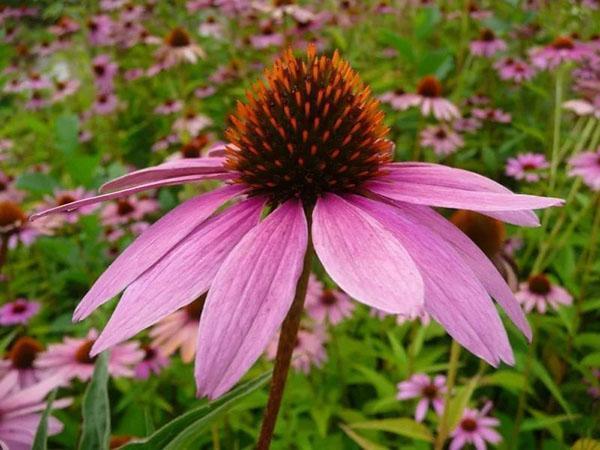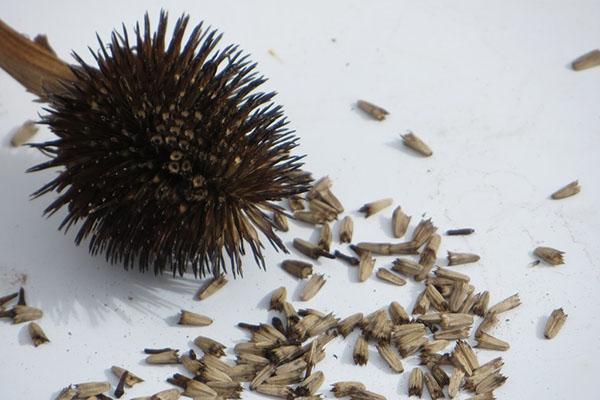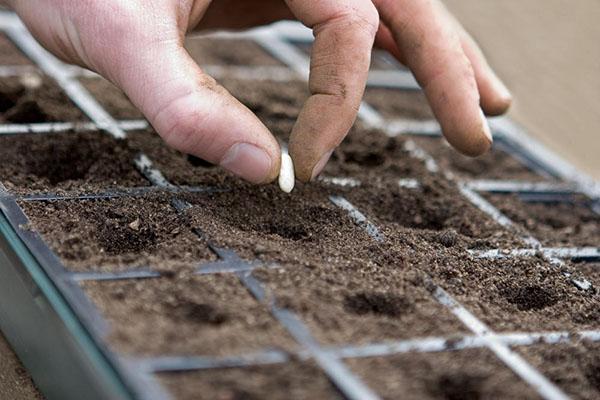Easy planting and caring for perennial echinacea
 If the planting and caring for perennial echinacea is correct, then the plant will certainly delight you with a neat appearance and colorful buds. Cultivation of this type of plant from seed is only suitable for varietal plants. With this method of propagation, hybrids lose their varietal characteristics and characteristics.
If the planting and caring for perennial echinacea is correct, then the plant will certainly delight you with a neat appearance and colorful buds. Cultivation of this type of plant from seed is only suitable for varietal plants. With this method of propagation, hybrids lose their varietal characteristics and characteristics.
Sowing in open ground

When the first sprouts appear, the plants are thinned out so that there is a distance of 7-8 cm between them, the second time they leave gaps of 10-15 cm.There should be a space of 40-50 cm between adult specimens.If the echinacea varieties are small, then enough 20 to 30 cm. All specimens that remain after such thinning are simply transplanted to another, free place.
The first season after sowing, Echinacea builds up and strengthens the roots, so it will bloom the next summer.
Sowing seedlings at home
 Ready-made seedlings grown at home can be planted on flower beds. In order to get quality specimens, you need to properly prepare the planting material. Since the seeds of the flower are covered with a dense skin, they should be soaked in water at room temperature or in a growth stimulator before sowing, which is more effective. But even with this preparation, the first shoots will appear above the ground no earlier than a month later. Seeds are sown to get good seedlings at the very end of winter. The capacity can be any: box, wooden container, individual containers.
Ready-made seedlings grown at home can be planted on flower beds. In order to get quality specimens, you need to properly prepare the planting material. Since the seeds of the flower are covered with a dense skin, they should be soaked in water at room temperature or in a growth stimulator before sowing, which is more effective. But even with this preparation, the first shoots will appear above the ground no earlier than a month later. Seeds are sown to get good seedlings at the very end of winter. The capacity can be any: box, wooden container, individual containers.
Sowing features:
- The soil mixture is not dense, but with good air circulation, with drainage.
- Bury the seeds in the soil quite a bit - by 5-10 mm.
- Leave intervals of 5-7 cm between the grains.
- After planting, cover the seeds with foil. The container should be kept in a well-lit place at a temperature of at least 13-15 degrees.
- When sprouts appear, clean the greenhouse. Water as needed to keep the soil moderately moist.
- Starting in May, the seedlings must be hardened. To do this, take out the containers to fresh air for 2-3 hours, then increase the duration of the procedure by an hour every day.
Towards the end of May, when there will definitely be no frost, and the seedlings will get stronger, plant them in flower beds.
Planting and caring for perennial echinacea
 For flower cultivation, it is preferable to choose the most lighted areas, where there is a lot of sun. The land should be rich in nutrients. As for the acidity, the indicator should be closer to neutral. If the soil has overestimated figures, then before using it, you need to add a small amount of lime.
For flower cultivation, it is preferable to choose the most lighted areas, where there is a lot of sun. The land should be rich in nutrients. As for the acidity, the indicator should be closer to neutral. If the soil has overestimated figures, then before using it, you need to add a small amount of lime.
Soil with a lot of sand is unsuitable for echinacea.
Landing rules:
- For planting seedlings, prepare holes about 5 cm deep. If these are delenki, then the size of the holes should be slightly larger than the rhizome.
- Gaps of 30 cm should be left between individual copies.
- A little humus is poured into each hole.
 For purchased echinacea, the depth of the dimple should be at least 0.4 m. The third part of the depression must be covered with a mixture of earth with river sand and humus. All components should be taken in equal amounts.
For purchased echinacea, the depth of the dimple should be at least 0.4 m. The third part of the depression must be covered with a mixture of earth with river sand and humus. All components should be taken in equal amounts.
Carefully remove the seedling from the flowerpot, without destroying the earthen lump, and transfer it into the hole. It is recommended to deepen the plant at the same level as in the pot.
Echinacea propagation by dividing the bush and cuttings
 Dividing the bush is an easy way to propagate echinacea. This is the best option with a guaranteed result. Choose an echinacea that is 3 or 4 years old. The second half of spring is suitable for seating. The bush is dug up, the rhizome is divided.
Dividing the bush is an easy way to propagate echinacea. This is the best option with a guaranteed result. Choose an echinacea that is 3 or 4 years old. The second half of spring is suitable for seating. The bush is dug up, the rhizome is divided.
Each part is treated with a growth stimulant, then the plant will take root better.
Propagating a flower by grafting is much more difficult. But, if you decide to try your hand, then this should be done at the very beginning of summer. Choose strong, undamaged stems. Cuttings are cut from them so that two leaves remain. Slices must be immersed in root stimulant, after which they are placed in a nutritious and moist soil. Root the planting material in the warmth at + 22 ° C - +250 C. The appearance of the first leaves on the cuttings is a good indication that roots are forming.
It will take about 2 months for the plants to grow stronger and grow rhizomes. After that, they can be transplanted to a permanent place.
How to care for echinacea in the garden
 The flower should be watered often, but in moderation. In hot summer, irrigation is carried out after the sun goes down. If the weather is cloudy, then as the earth dries up. For young plants watering spend under the root. It is also recommended to periodically spray the bushes.
The flower should be watered often, but in moderation. In hot summer, irrigation is carried out after the sun goes down. If the weather is cloudy, then as the earth dries up. For young plants watering spend under the root. It is also recommended to periodically spray the bushes.
If the soil in the garden is fertile, you can not fertilize the flower additionally. For poor soil, in the spring, they make preparations with a sufficient amount of nitrogen: saltpeter, cow dung, urea... Fertilize again during flowering with complex agents with potassium and phosphorus.
If echinacea is grown as a medicinal raw material, then feeding is not carried out.
Echinacea pruning. All drying flowers are immediately removed. This makes the bush neater and stimulates it to bloom again. Before wintering, cut off all trunks with foliage.
How to collect echinacea seeds. The seed is harvested by choosing dry, almost black heads, similar to hedgehogs. They are cut with a small handle, folded in paper bags and stored in a dark room.
Echinacea preparation for winter. The flower tolerates frost well, but requires some preparation. In addition to pruning, the area around the root is mulched, first with compost, and then with dried foliage. With such a shelter, one-year-old specimens safely endure the winter and will bloom magnificently.
Diseases and pests of echinacea
 Echinacea often suffers from fusarium, which is caused by a fungus that lives in the ground. It leads to decay of the rhizome and base of the trunks. To fight the infection, the affected specimens are destroyed, and all other plants are sprayed with a solution of foundationol.
Echinacea often suffers from fusarium, which is caused by a fungus that lives in the ground. It leads to decay of the rhizome and base of the trunks. To fight the infection, the affected specimens are destroyed, and all other plants are sprayed with a solution of foundationol.
Powdery mildew is another fungal infection. It can be recognized by a white bloom - mold on foliage and shoots. It appears due to waterlogging of the soil. Therefore, the bushes are sprayed with Bordeaux liquid, and the earth is allowed to dry out.
 Whitefly settles on the inner surface of leaf blades. Because of these small whitish insects, the flower dries quickly. Spraying with insecticides such as Aktara or Confidor will help to get rid of the whitefly.
Whitefly settles on the inner surface of leaf blades. Because of these small whitish insects, the flower dries quickly. Spraying with insecticides such as Aktara or Confidor will help to get rid of the whitefly.
All varieties of echinacea are a worthy decoration of flower beds. Gardeners love this plant, which can change any landscape design. Moreover, non-capricious echinacea blooms not only all summer, but also until October.